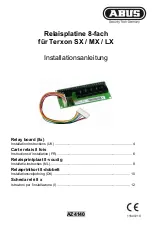
IG-150-EN version 04; 03/10/16
92
Protection functions. Description and settings
General instructions
ekor.rps
4.20.3. Protection trip mask (6 tables)
This setting can only be programmed using a PC, not by
keyboard/display.
There are three types of mask for the protection functions
that may cause “unconditional” “permissive” and “blocked”
trip. This mask is only examined if “enable masks” setting is
set as “YES”. If it is as “NO”, trips are allowed without taking
into account the masks.
Trip causes set as “YES” at “unconditional” mask, gives a trip
after expiring the trip time set, without taking into account
the pilot wire scheme. Unconditional trip output and general
trip output are activated.
Trip causes set as “YES” at “permissive” mask, gives a trip with
acceleration by permissive logic only if permissive logics
(Overreach, underreach or directional unlocking) are selected
in trip logic settings. If a trip with acceleration is given, “pilot
wire scheme trip” output will be activated and not general
trip output.
Trip causes set as “YES” at “blocked” mask, give a trip
with acceleration by blocking logic, only if locking logics
(Directional Locking) are selected in trip logic settings. If
a trip with acceleration is given, “Pilot wire scheme trip”
output will be activated and not general trip output.
You can simultaneously select for a function unconditional
and permissive or unconditional and locking, in this way the
trips of the units indicated in the permissive and blocked
mask can be accelerated, if the adequate conditions are
given.
It has to be taken into account that these masks are examined
in the moment of giving the trip command; therefore it has
no effect if the function is disabled by setting. Let’s suppose,
for example that “neutral instantaneous in zones 1, 2 and
3” functions are set as “YES” in unconditional trip mask, but
“neutral instantaneous” is set as “NO” in trip permission after
closing, after second reclosure. During security time after
second reclosure it will not trip by neutral instantaneous,
because this command will not even be executed.
4.20.4. Used signals
Below the meaning is explained:
ETP: Is called the teleprotection signal sent by a terminal. In
any event, the ETP signal sent by a terminal is kept active for
at least 50 ms, even though the reason that has caused its
activation may disappear.
RTPE y RTP: Both are different, and therefore the RTPE is
the input of the teleprotection received by a terminal; while
the RTP follows the RTPE input in order to get activated,
but it keeps the input stored for the TRTP time in order to
be deactivated. If TRTP is adjusted equal to zero, then the
RTP coincides with the RTPE input. In the teleprotection
schemes, RTP is used.
Z3(R)MEM: Locking signal due to reverse direction change.
See the section that corresponds to reverse direction
locking.
MINC trip: OR of enabled protection units for unconditional
trips that have trip. These units will trip after the time set,
without taking into account the pilot wire schemes.
MPER pickup: OR of enabled protection units for permissive
trips that have picked up. These units will trip if they have
pickup when the teleprotection signal/RTP MEM) reach
them. If they do not receive permission by this input, they
do not trip.
MBLOQ pickup: OR of enabled protection units for
blocked trips that have picked up. These units will trip, if
they continue in pickup status, after exceeding the locking
signal time (TBLQ) and the signal (RTP) has not arrived. If
they were locked by this input, they would not trip.
Figure 4.24.
Teleprotection reception
Summary of Contents for ekor.rps
Page 143: ......
















































